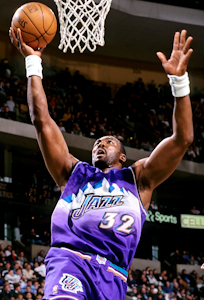Power forward
The power forward (literally "powerful (full) attacking player") in English also four or 4 , is one of five positions in basketball . It is part of the front court , which also includes small forward and center . As a rule, Power Forwards are slightly smaller than Center, but larger than the rest of the positions.
Requirements and style of play

The power forward traditionally scores just like the center near the basket and is jointly responsible for rebound work - capturing balls after ricocheting off the board or the ring - on the offensive and defensive.
In recent years, however, the requirements for a power forward have changed fundamentally. Many teams want their power forwards to throw threesomes regularly and thereby open the game. In American, the term stretch four is used for this , which literally translates as a power forward that "stretches the playing field" or "makes it wider". This also meant that now many players play on the 4, which is actually the size of a leading small forward have or previously played small forward.
history
The term "forward" comes from the time the sport of basketball was developed , when players - like in football - were divided into attackers (forwards) and defenders (guards). The forward was mainly responsible for scoring, primarily by pulling towards the basket. The division into small and power forward has only existed in this form since the 1970s. Previously, there was no distinction between the two positions, but they were given similar tasks, although these were more like the tasks of today's small forward. Most NBA teams of the 1960s and earlier therefore typically had two very similar players on 3 and 4, such as the Philadelphia 76ers with Chet Walker and Billy Cunningham .
Since the 1970s, a filigree center began to be given a beefy forward, as an enforcer , so to speak (for example, Maurice Lucas next to Bill Walton or Spencer Haywood next to Bob McAdoo ). The position of the power forward developed from the play of these centers, which were originally rather too small.
In the 1970s, almost every team had an enforcer in their ranks. And just as in ice hockey (where the name "enforcer" originally comes from), the game was brutalized. On December 9, 1977, the Los Angeles Lakers and Houston Rockets game came to a decisive event: Lakers enforcer Kermit Washington hit Rockets player Rudy Tomjanovich so hard on the head with a punch that the front skull was smashed. Tomjanovich barely survived the injury, and then the NBA was forced to put an end to the fistfights.
With Kevin McHale came at the beginning of the 1980s, the prototype of a power forward in the NBA. Thanks to his large repertoire of attacking moves, McHale was long one of the top players in the NBA and was inducted into the Naismith Memorial Basketball Hall of Fame in 1999 . Like McHale, many of the power forwards that followed him were among the most attacking players in the NBA, from Charles Barkley and Karl Malone to Chris Webber to Kevin Garnett , Tim Duncan and Dirk Nowitzki . The latter in particular are characterized by their extraordinary versatility in attack.
Today's power forward generation is shaped by players like Blake Griffin , LaMarcus Aldridge or Anthony Davis , who, in addition to the traditional tasks of a foursome, also take regular distance throws in order to open up the playing field.
See also
literature
- André Voigt: Power Forwards. With all my might , in: Five # 23 (12-2005), pp. 60–65.
Web links
|
||||||||||||||||||||||
